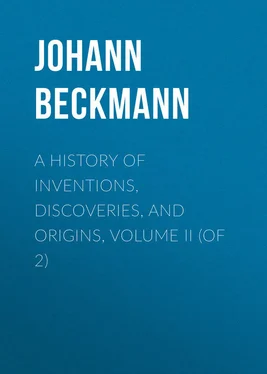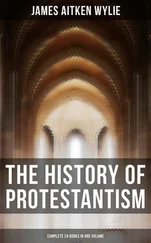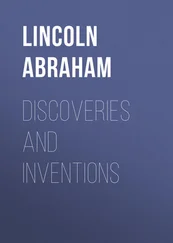Johann Beckmann - A History of Inventions, Discoveries, and Origins, Volume II (of 2)
Здесь есть возможность читать онлайн «Johann Beckmann - A History of Inventions, Discoveries, and Origins, Volume II (of 2)» — ознакомительный отрывок электронной книги совершенно бесплатно, а после прочтения отрывка купить полную версию. В некоторых случаях можно слушать аудио, скачать через торрент в формате fb2 и присутствует краткое содержание. Жанр: foreign_antique, foreign_prose, на английском языке. Описание произведения, (предисловие) а так же отзывы посетителей доступны на портале библиотеки ЛибКат.
- Название:A History of Inventions, Discoveries, and Origins, Volume II (of 2)
- Автор:
- Жанр:
- Год:неизвестен
- ISBN:нет данных
- Рейтинг книги:4 / 5. Голосов: 1
-
Избранное:Добавить в избранное
- Отзывы:
-
Ваша оценка:
- 80
- 1
- 2
- 3
- 4
- 5
A History of Inventions, Discoveries, and Origins, Volume II (of 2): краткое содержание, описание и аннотация
Предлагаем к чтению аннотацию, описание, краткое содержание или предисловие (зависит от того, что написал сам автор книги «A History of Inventions, Discoveries, and Origins, Volume II (of 2)»). Если вы не нашли необходимую информацию о книге — напишите в комментариях, мы постараемся отыскать её.
A History of Inventions, Discoveries, and Origins, Volume II (of 2) — читать онлайн ознакомительный отрывок
Ниже представлен текст книги, разбитый по страницам. Система сохранения места последней прочитанной страницы, позволяет с удобством читать онлайн бесплатно книгу «A History of Inventions, Discoveries, and Origins, Volume II (of 2)», без необходимости каждый раз заново искать на чём Вы остановились. Поставьте закладку, и сможете в любой момент перейти на страницу, на которой закончили чтение.
Интервал:
Закладка:
In the year 1479 Sixtus IV. confirmed the lending-house which had been established at Savona, the place of his birth, upon the same plan as that at Perugia. The bull issued for this purpose is the first pontifical confirmation ever printed 12 12 It may be found in Bolle et Privilegi del Sacro Monte della Pietà di Roma. In Roma, 1618: ristampati l’anno 1658. This collection is commonly bound up with the following work, which was printed in the same year and again reprinted: Statuti del Sacro Monte della Pietà di Roma. This bull is inserted entire by Ascianus, p. 719, but in the Collection of the pontifical bulls it is omitted.
; for that obtained for Perugia was not, as we are told by the editor, to be found in the archives there in 1618, the time when the other was printed. I have never found the confirmation of those at Orvieto and Viterbo. Ascianus sought for them, but without success, in Bullarium Magnum Cherubini, and they are not mentioned by Sixtus. This pontiff, in his bull, laments that the great expenses to which he was subjected did not permit him to relieve his countrymen with money, but that he would grant to the lending-house so many spiritual advantages, as should induce the faithful to contribute towards its support; and that it was his desire that money should be lent from it to those who would assist gratis during a year in the business which it required. If none could be found to serve on these conditions, a moderate salary was to be given. He added a clause also respecting pledges; but passed over in silence that the debtors were to contribute anything for the support of the institution by paying interest, which Barnabas, whose name does not occur in the bull, introduced however at Perugia, and which the pope tacitly approved.
The greater part of the lending-houses in Italy were established in the fifteenth and following centuries by the Minorites Marcus Bononiensis, Michael a Carcano 13 13 This Michael travelled and preached much in company with Bernardinus, and died at Como in 1485. – Wadding, xiv. p. 396.
, Cherubinus Spoletanus, Jacobus de Marchia, Antonius Vercellensis, Angelus a Clavasio, and above all, Bernardinus Tomitano, named also Feltrensis and Parvulus . This man was born at Feltri, in the country of Treviso, in the year 1439. His father was called Donato Tomitano, and his mother Corona Rambaldoni; they were both of distinguished families, though some assert that he was of low extraction, and a native of Tomi, a small place near Feltri, on which account he got the name of Tomitano. The name of Parvulus arose from his diminutive stature, which he sometimes made a subject of pleasantry 14 14 The Piccolimini, nephews of the pope, having once paid their respects to him at Siena, he told them he was their namesake. – Wadding, xiv. p. 447.
. This much at any rate is certain, that he had received a good education. In 1456, when seventeen years of age, he suffered his instructors, contrary to the inclination of his father, to carry him to Padua, to be entered in the order of the Minorites; and on this occasion he changed his christian-name Martin into Bernardinus. As he was a good speaker, he was employed by his order in travelling through Italy and preaching. He was heard with applause, and in many parts the people almost paid him divine honours. The chief object of his sermons was to banish gaming, intemperance, and extravagance of dress; but he above all attacked the Jews, and excited such a hatred against them, that the governments in many places were obliged to entreat or to compel him either to quit their territories or not to preach in opposition to these unfortunate people, whom the crowds he collected threatened to massacre; and sometimes when he visited cities where there were rich Jews and persons who were connected with them in trade, he was in danger of losing even his own life. Taking advantage of this general antipathy to the Jews, he exerted himself, after the example of Barnabas, his brother Minorite, to get lending-houses established, and died at Pavia in the year 1494. The Minorites played a number of juggling tricks with his body, pretending that it performed miracles, by which means they procured him a place in the catalogue of the saints; and to render his name still more lasting, some of his sermons have been printed among the works of the writers of the Franciscan order 15 15 Waddingii Scriptores Ordinis Minorum, p. 58. Fabricii Biblioth. Mediæ et Infimæ Æt. i. p. 586.
.
The lending-houses in Italy, with the origin of which I am acquainted, are as follows: – The lending-house at Perugia was inspected in 1485 by Bernardinus, who enlarged its capital.
The same year he established one at Assisi, which was confirmed by Pope Innocent, and which was visited and improved by its founder in 1487 16 16 Wadding, xiv. pp. 398, 433.
.
In the year 1486, after much opposition, he established a lending-house at Mantua, and procured for it also the pope’s sanction 17 17 It may be found entire in Wadding, xiv. p. 411. It was ordered that the pledges should be worth double the sum lent, and that they should be sold if not redeemed within a year.
. Four years after, however, it had declined so much, that he was obliged to preach in order to obtain new donations to support it.
At Florence he met with still more opposition; for the rich Jews bribed the members of the government, who wished in appearance to favour the establishment of the lending-house, to which they had consented eighteen years before, while they secretly thwarted it; and some boys having once proceeded, after hearing a sermon, to attack the houses of the Jews, the Minorites were ordered to abstain from preaching and to quit the city 18 18 Wadding, xiv. p. 446.
. It was however completely established; but by the Dominican Hieronymus Savonarola 19 19 D. Manni circa i Sigilli Antichi, tom. xxvii. p. 92, where much information respecting this subject may be found.
.
In the year 1488 Bernardinus established a lending-house at Parma, and procured for it the pope’s sanction, as well as for one at Cesena, where the interest was defined to be “pro salariis officialium et aliis montis oneribus perferendis.” About the conclusion of this year he was at the other end of Italy, where he re-established the lending-house at Aquila in the kingdom of Naples 20 20 Wadding, xiv. p. 451.
.
In the year following he established one at Chieti ( Theate ) in the same kingdom, another at Rieti ( Reate ) in the territories of the Church, a third at Narni ( Narnia ) 21 21 Ibid. pp. 462, 465.
; and a fourth at Lucca, which was confirmed by the bishop, notwithstanding the opposition of the Jews, who did every thing in their power to prevent it.
In the year 1490 a lending-house was established at Piacenza ( Placentia ) by Bernardinus, who at the same time found one at Genoa which had been established by the before-mentioned Angelus a Clavasio 22 22 Ibid. xiv. pp. 480, 481.
. At this period also a lending-house was established at Verona 23 23 Ibid. p. 517.
, and another at Milan by the Minorite Michael de Aquis.
In 1491 a lending-house was established at Padua, which was confirmed by Pope Alexander VI. in 1493 24 24 Ibid. xiv. pp. 93, 482.
; and another was established at Ravenna 25 25 Ibid. p. 514.
.
In 1492 Bernardinus reformed the lending-house at Vicenza, where, in order to avoid the reproach of usury, the artifice was employed of not demanding any interest, but admonishing the borrowers that they should give a remuneration according to their piety and ability. As people were by these means induced to pay more interest than what was legally required at other lending-houses, Bernardinus caused this method to be abolished 26 26 Ibid. xv. pp. 6, 65.
. He established a lending-house also the same year in the small town of Campo S. Pietro, not far from Padua, and expelled the Jews who had lent upon pledges. At this period there were lending-houses at Bassano, a village in the county of Trevisi, and also at Feltri, which he inspected and improved 27 27 Wadding, xv. pp. 7, 9, 12.
.
Интервал:
Закладка:
Похожие книги на «A History of Inventions, Discoveries, and Origins, Volume II (of 2)»
Представляем Вашему вниманию похожие книги на «A History of Inventions, Discoveries, and Origins, Volume II (of 2)» списком для выбора. Мы отобрали схожую по названию и смыслу литературу в надежде предоставить читателям больше вариантов отыскать новые, интересные, ещё непрочитанные произведения.
Обсуждение, отзывы о книге «A History of Inventions, Discoveries, and Origins, Volume II (of 2)» и просто собственные мнения читателей. Оставьте ваши комментарии, напишите, что Вы думаете о произведении, его смысле или главных героях. Укажите что конкретно понравилось, а что нет, и почему Вы так считаете.












